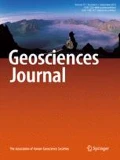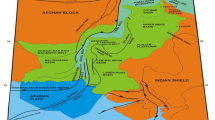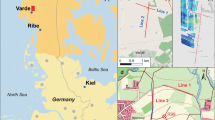Abstract
We conducted a vertical electrical sounding (VES) survey over the Quaternary sediments covering a transitional region between the eastern part of the Chiang Mai rift basin and the Mae On Depression, northern Thailand and constructed 1D lithologic subsurface models for delineating geological structures of the underlying basement rocks. Thirteen VES stations were collected and divided into northern and southern sub-parallel alignments trending WSW-ENE across the high magnetic contrast zone. We employed a Schlumberger array with the maximum half current electrode separations around 465–500 m, using the ABEM Terrameter SAS4000 resistivity meter. The VES data were inverted using EarthImager™ 1D program. We classified four geoelectric units composed of (1) very-low-resistivity saturated sediments (17–39 Ωm), (2) low-resistivity unsaturated sediments (33–581 Ωm), (3) medium-resistivity sedimentary rocks (57–110 Ωm), and (4) high-resistivity mafic volcanic rocks (176–804 Ωm). Shallow zones of the geoelectric models were interpreted as sediment fill with layered strata with variable resistivity because of different water saturation and clay content. The sediment fill thickens westward to the Chiang Mai rift basin. Deeper zones of higher resistivity are interpreted as the underlying basement rocks. These basement rocks show contrasting resistivities with the western part modeled as clastic sedimentary rocks of sandstone and the eastern part as mafic volcanic rocks. Geological observation evidence of westward-dipping faults and chronostratigraphic results integrated with the 1D lithologic models and drilled well information support a structural model of a reverse fault trending SW-NE between the Permian volcanic and Carboniferous sedimentary basements. This structure is part of the Chiang Mai-Chiang Rai Suture Zone associated with the eastward subduction model during the Permo-Triassic Indosinian Orogeny in northern Thailand.
Similar content being viewed by others
References
Akinlalu, A.A., Bawallah, M., Adiat, K.A.N., Ajayi-Gidi, I.O., and Osanyingbemi, B., 2015, The use of vertical electrical sounding (VES) for earthling protection design. International Journal of Research Studies in Science, Engineering and Technology, 2, 1–8.
Bunopas, S., 1981, Paleogeographic history of western Thailand and adjacent parts of Southeast Asia — a plate tectonic interpretation. Doctoral Dissertation, Victoria University of Wellington, Wellington, 811 p.
Bunopas, S. and Vella, P., 1983, Tectonic and geologic evolution of Thailand. Proceedings of the Workshop on Stratigraphic Correlation of Thailand and Malaysia, Hat Yai, Sep. 8–10, p. 307–322.
Burger, H.R., Sheehan, A.F., and Jones, C.H., 2006, Introduction to Applied Geophysics: Exploring the Shallow Subsurface. W.W. Norton & Company, New York, 554 p.
Chaisri, S., Lerkrattanawaree, S., Mankhemthong, N., Udphuay, S., and Kruachanta, M., 2020, Near-surface geophysical investigation in Mae On, Chiang Mai, Thailand. Songklanakarin Journal of Science and Technology, 42, 1336–1345.
Chaodumrong, P., Ukakimapan, Y., Snansieng, S., Janmaha, S., Pradidtan, S., and Sae Leow, N., 1983, A review of the Tertiary sedimentary rocks of Thailand. Proceedings of Workshop on Stratigraphic Correlation of Thailand and Malaysia, Hat Yai, Sep. 8–10, p. 159–187.
Charusiri, P., Clark, A.H., Farrar, E., Archibald, D., and Charusiri, B., 1993, Granite belts in Thailand: evidence from the 40Ar/39Ar geochronological and geological syntheses. Journal of Southeast Asian Earth Sciences, 8, 127–136.
Chaturongkawanich, S. and Chuaviroj, S., 1983, Some aspect of core study from well GTE1 and GTE2, San Kamphaeng geothermal area, Chiang Mai, Thailand. Proceedings of the Conference on Geology and Mineral Resources of Thailand, Bangkok, Oct. 28–29, p. 346–352.
Cobbing, E.J., 2011, Granitic rocks. In: Ridd, M.F., Barber, A.J., and Crow, M.J. (eds.), The Geology of Thailand. Geological Society, London, Geology of Series, p. 441–458.
Department of Groundwater Resources, 2015, National groundwater database. http://app.dgr.go.th/newpasutara/xml/Krabi.flles/ [Accessed on 1 May 2019].
Department of Mineral Resources, 2018, Active fault map of Thailand. http://www.dmr.go.th/main.php?fllename=fault_en [Accessed on 10 December 2018].
Hara, H., Kunii, M., Hisada, K., Ueno, K., Kamata, Y., Srichan, W., Charusiri, P., Charoentitirat, T., Watarai, M., Adachi, Y., and Kurihara, T., 2012, Petrography and geochemistry of clastic rocks within the Inthanon zone, northern Thailand: implications for Paleo-Tethys subduction and convergence. Journal of Asian Earth Science, 61, 2–15.
Hara, H., Kunii, M., Miyake, Y., Hisada, K., Kamata, Y., Ueno, K., Kon, Y., Kurihara, T., Ueda, H., Assavapatchara, S., Treerotchananon, A., Charoentitirat, T., and Charusiri, P., 2017, Sandstone provenance and U-Pb ages of detrital zircons from Permian-Triassic forearc sediments within the Sukhothai Arc, northern Thailand: record of volcanic arc evolution in response to Paleo-Tethys subduction. Journal of Asian Earth Sciences, 146, 30–55.
Hara, H., Wakita, K., Ueno, K., Kamata, Y., Hisada, K., Charusiri, P., Charoentitirat, T., and Chaodumrong, P., 2009, Nature of accretion related to Paleo-Tethys subduction recorded in northern Thailand: constraints from mélange kinematics and illite crystallinity. Gondwana Research, 16, 310–320.
Jivacate, C., 1985, Well logging at the San Kamphaeng geothermal area, Northern Thailand. Geothermal Resources Council Transactions, 9, 549–555.
Mankhemthong, N., Lerkrattanawaree, S., Kanthiya, S., Suntamano, S., Siri, T., Teeyaphan, K., and Chaimongkon, K., 2016, Geological interpretation of Mae On Area, Chiang Mai Province, based on modeling of ground gravity and magnetic data. The 7th International Conference on Applied Geophysics (Abstract), Bangkok, Jan. 14–15, p. 31.
Mankhemthong, N., Morley, C.K., and Srichan, W., 2020, Structure of the Mae On Depression, Chiang Mai province, based on gravity modeling and geological field observation: implications for tectonic evolution of the Chiang Mai-Chiang Rai Suture Zone, Northern Thailand. Journal of Asian Earth Sciences, 190, 104186.
Mankhemthong, N., Takaew, P., Morley, K.C., and Rhodes, B.R., 2019, Structure and evolution of the Ban Pong Basin, Chiang Mai Province, Thailand. Journal of Asian Earth Sciences, 172, 208–220.
Metcalfe, I., Henderson, C.M., and Wakita, K., 2017, Lower Permian conodonts from Palaeo-Tethys Ocean Plate stratigraphy in the Chiang Mai-Chiang Rai Suture Zone, northern Thailand. Gondwana Research, 44, 54–66.
Morley, C.K., 2009, Geometry and evolution of low-angle normal faults (LANF) within a Cenozoic high-angle rift system, Thailand: implications for sedimentology and the mechanisms of LANF development. Tectonics, 28, 1–30.
Morley, C.K., Charusiri, P., and Watkinson, I.M., 2011, Structural geology of Thailand during the Cenozoic. In: Ridd, M.F., Barber, A.J., and Crow, M.J. (eds.), The Geology of Thailand. Geological Society, London, Geology of Series, p. 273–334.
Morley, C.K. and Racey, A., 2011, Tertiary stratigraphy. In: Ridd, M.F., Barber, A.J., and Crow, M.J. (eds.), The Geology of Thailand. Geological Society, London, Geology of Series, p. 223–271.
Nakapadungrat, S., Beckinsale, R.D., and Suensilpong, S., 1984, Geochronology and geology of Thai granites. Proceedings of Conference on Applications of Geology and the National Development, Bangkok, Nov. 19–22, p. 75–93.
Orellana, E. and Mooney, H.M., 1966, Master tables and curves for vertical electrical sounding over layered structures. Interciencia, Madrid, 193 p.
Parkhomenko, E.I., 1967, Electrical Properties of Rocks. Plenum Press, New York, 314 p.
Patil, S.N., Marathe, N.P., Kachate, N.R., Ingle, S.T., and Golekar, R.B., 2015, Electrical resistivity techniques for groundwater investigation in Shirpur taluka of Dhule district, Maharashtra state, India. International Journal of Recent Trends in Science and Technology, 15, 567–575.
Phajuy, B., Panjasawatwong, Y., and Osataporn, P., 2005, Preliminary geochemical study of volcanic rocks in the Pang Mayao area, Phrao, Chiang Mai, northern Thailand: tectonic setting of formation. Journal of Asian Earth Sciences, 24, 765–776.
Piyasin, S., 1972, Geology of Lampang Sheet NE 47-7 (1: 250,000). Geological Survey Division, Department of Mineral Resources, Bangkok, 98 p.
Rhodes, B.P., Conejo, R., Benchawan, T., Titus, S., and Lawson, R., 2005, Paleocurrents and provenance of the Mae Rim Formation, Northern Thailand: implications for tectonic evolution of the Chiang Mai Basin. Journal of the Geological Society of London, 162, 51–63.
Rhodes, B.R., Perez, R., Lamjuan, A., and Kosuwan, S., 2003, Kinematics and tectonic implications of the Mae Kuang Fault, northern Thailand. Journal of Asian Earth Sciences, 24, 79–89.
Ridd, M.F., 2015, East flank of the Sibumasu block in NW Thailand and Myanmar and its possible northward continuation into Yunnan: a review and suggested tectono-stratigraphic interpretation. Journal of Asian Earth Sciences, 104, 160–170.
Sharma, P.V., 1997, Environmental and Engineering Geophysics. Cambridge University Press, Cambridge, 475 p.
Singharajwarapan, F.S., Wood, S.H., Fuangswasdi, A., and Pirarai, K., 2015, Anomalous fluoride and warm water wells may indicate blind geothermal systems in Cenozoic basins of northwestern Thailand. Proceedings of the World Geothermal Conference, Melbourne, Apr. 19–24, 15 p.
Sundararajan, N., Sankaran, S., and Al-Hosni, T.K., 2012, Vertical electrical sounding (VES) and multi-electrode resistivity in environmental impact assessment studies over some selected lakes: a case study. Environmental Earth Sciences, 65, 881–895.
Ueno, K. and Charoentitirat, T., 2011, Carboniferous and Permian. In: Ridd, M.F., Barber, A.J., and Crow, M.J. (eds.), The Geology of Thailand. Geological Society, London, Geology of Series, p. 71–136
Wakita, K. and Metcalfe, I., 2005, Ocean plate stratigraphy in East and Southeast Asia. Journal of Asian Earth Sciences, 24, 679–702.
Wang, Y., He, H., Zhang, Y., Srithai, B., Feng, Q., Cawood, P., and Fan, W., 2017, Origin of Permian OIB-like basalts in NW Thailand and implication on the Paleotethyan Ocean. Lithos, 274–275, 93–105.
Ward, S.H., 1990, Resistivity and induced polarization methods. In: Ward, S.H. (ed.), Geotechnical and Environmental Geophysics: Vol. 1, Review and Tutorial. Society of Exploration Geophysicists, Special Publication, 5, p. 147–189.
Wattananikorn, K., Beshir, J.A., and Nochaiwong, A., 1995, Gravity interpretation of Chiang Mai Basin, northern Thailand: concentrating on Ban Thung Sieo area. Journal of Southeast Asian Earth Science, 12, 53–64.
Wentworth, C.K., 1922, A scale of grade and class terms for clastic sediments. The Journal of Geology, 30, 377–392.
Acknowledgments
We are grateful to Adul Yawichai, Chanin Maetmueang, Khemjira Chuthadhaweesin, Tanakon Nunta, Tunkunut Chuesomkiat, and other geophysical field crews for data acquisition and technical help. We appreciate Christopher Morley, Siriporn Chaisri, Weerapan Srichan, Pitaksit Ditbanjong, Ronnakrit Sakuntanaga, and Srivipa Lerkrattanawaree, for suggestions on resistivity survey and geological field observation contents in a locality. We would like to thank Robert Kieckhefer for helpful comments that improved the manuscript. We thank Spencer Wood and an anonymous reviewer for helpful comments that improved the manuscript and Tae-Seob Kang and Bokyun Ko for editorial help. We acknowledge the Department of Geological Sciences, Chiang Mai University, for the resistivity tool and processing software support and the National Science and Technology Development Agency, Thailand, for research fund.
Author information
Authors and Affiliations
Corresponding author
Additional information
Publisher’s Note
Springer Nature remains neutral with regard to jurisdictional claims in published maps and institutional affiliations.
Electronic supplementary material
Rights and permissions
About this article
Cite this article
Mankhemthong, N., Phanratana, C. & Udphuay, S. Lithologic modeling using VES method for subsurface structure delineation with geological constraints, eastern margin of Chiang Mai Basin and southwestern margin of Mae On Depression, San Kamphaeng District, Chiang Mai Province, northern Thailand. Geosci J 25, 479–494 (2021). https://doi.org/10.1007/s12303-020-0037-4
Received:
Accepted:
Published:
Issue Date:
DOI: https://doi.org/10.1007/s12303-020-0037-4




